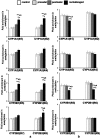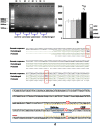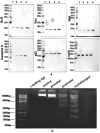Imprinting of cerebral cytochrome P450s in offsprings prenatally exposed to cypermethrin augments toxicity on rechallenge
- PMID: 27853314
- PMCID: PMC5112598
- DOI: 10.1038/srep37426
Imprinting of cerebral cytochrome P450s in offsprings prenatally exposed to cypermethrin augments toxicity on rechallenge
Abstract
Epigenetic studies were carried in the rat offsprings, born to dams treated with cypermethrin (orally; 5.0 mg/kg) from gestation day (GD) 5 to 21 and rechallenged with cypermethrin (orally; 10 mg/kg for 6 days), at adulthood (12 weeks) to understand the mechanism underlying the overexpression of cerebral cytochrome P450s (CYPs) in exposed offsprings. The data revealed alterations in histone H3 acetylation and DNA methylation in promoter regions of CYP1A- and 2B- isoenzymes in the brain isolated from rechallenged animals. Further, bisulphite sequencing revealed critical CpG methylation changes in BARBIE BOX (Barbiturate response element) and BTE (Basal transcription element) in promoter of CYP2B1 in the brain isolated from rechallenged animals. Western blotting and DNA laddering/fragmentation studies revealed a greater magnitude of increase in the signalling pathways associated with apoptosis in the rechallenged animals. The data have indicated that overexpression of cerebral CYPs could be due to the imprinting of CYPs. Further, increased apoptosis observed in the rechallenged offsprings has suggested that these epigenetic changes in CYPs may predispose the prenatally exposed offsprings to the neurotoxic effects of other centrally acting drugs and chemicals when subsequently rechallenged later at life.
Figures



Similar articles
-
Overexpression of cerebral cytochrome P450s in prenatally exposed offspring modify the toxicity of lindane in rechallenged offspring.Toxicol Appl Pharmacol. 2019 May 15;371:20-37. doi: 10.1016/j.taap.2019.03.022. Epub 2019 Mar 26. Toxicol Appl Pharmacol. 2019. PMID: 30926376
-
Imprinting of cerebral and hepatic cytochrome p450s in rat offsprings exposed prenatally to low doses of cypermethrin.Mol Neurobiol. 2013 Aug;48(1):128-40. doi: 10.1007/s12035-013-8419-5. Epub 2013 Feb 28. Mol Neurobiol. 2013. PMID: 23447098
-
Prenatal Exposure of Cypermethrin Induces Similar Alterations in Xenobiotic-Metabolizing Cytochrome P450s and Rate-Limiting Enzymes of Neurotransmitter Synthesis in Brain Regions of Rat Offsprings During Postnatal Development.Mol Neurobiol. 2016 Aug;53(6):3670-3689. doi: 10.1007/s12035-015-9307-y. Epub 2015 Jun 27. Mol Neurobiol. 2016. PMID: 26115703
-
Effect of Gestational Exposure of Cypermethrin on Postnatal Development of Brain Cytochrome P450 2D1 and 3A1 and Neurotransmitter Receptors.Mol Neurobiol. 2015 Aug;52(1):741-56. doi: 10.1007/s12035-014-8903-6. Epub 2014 Oct 7. Mol Neurobiol. 2015. PMID: 25288152
-
Effect of prenatal exposure of deltamethrin on the ontogeny of xenobiotic metabolizing cytochrome P450s in the brain and liver of offsprings.Toxicol Appl Pharmacol. 2006 Aug 1;214(3):279-89. doi: 10.1016/j.taap.2006.01.006. Epub 2006 Feb 21. Toxicol Appl Pharmacol. 2006. PMID: 16494911
Cited by
-
Exposure to Insecticides Modifies Gene Expression and DNA Methylation in Hematopoietic Tissues In Vitro.Int J Mol Sci. 2023 Mar 26;24(7):6259. doi: 10.3390/ijms24076259. Int J Mol Sci. 2023. PMID: 37047231 Free PMC article.
-
Pyrethroid pesticide exposure and placental effects.Mol Cell Endocrinol. 2023 Dec 1;578:112070. doi: 10.1016/j.mce.2023.112070. Epub 2023 Sep 16. Mol Cell Endocrinol. 2023. PMID: 37722502 Free PMC article. Review.
-
Cypermethrin Impairs Hippocampal Neurogenesis and Cognitive Functions by Altering Neural Fate Decisions in the Rat Brain.Mol Neurobiol. 2021 Jan;58(1):263-280. doi: 10.1007/s12035-020-02108-9. Epub 2020 Sep 13. Mol Neurobiol. 2021. PMID: 32920670
-
Imprinting and Reproductive Health: A Toxicological Perspective.Int J Mol Sci. 2023 Nov 21;24(23):16559. doi: 10.3390/ijms242316559. Int J Mol Sci. 2023. PMID: 38068882 Free PMC article. Review.
References
-
- Bloomquist J. R. Ion channels as targets for insecticides. Annu. rev. entomol. 41, 163–190 (1996). - PubMed
-
- Choi J. S. & Soderlund D. M. Structure-activity relationships for the action of 11 pyrethroid insecticides on rat Na v 1.8 sodium channels expressed in Xenopus oocytes. Toxicol. Appl. Pharm. 211, 233–244 (2006). - PubMed
-
- Ray D. E. & Fry J. R. A reassessment of the neurotoxicity of pyrethroid insecticides. Pharmacol. therapeutics 111, 174–193 (2006). - PubMed
-
- Dayal M. et al. Induction of rat brain cytochrome P450s (P450s) by deltamethrin: regional specificity and correlation with neurobehavioral toxicity. Neurotox. Res. 3, 351–357 (2001). - PubMed
Publication types
MeSH terms
Substances
LinkOut - more resources
Full Text Sources
Other Literature Sources

